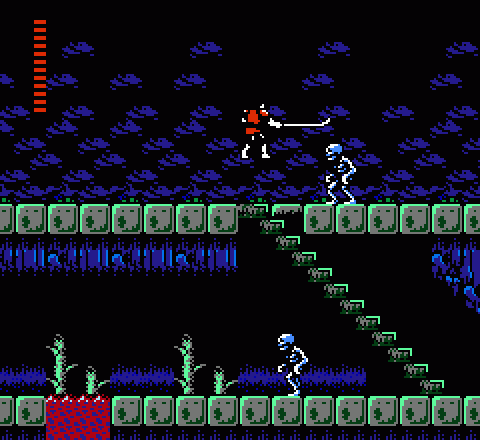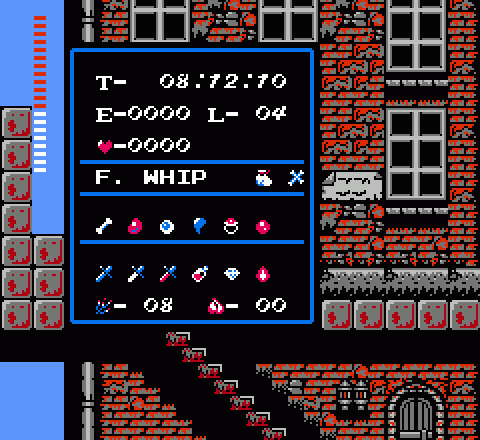Konami tried something bold with Castlevania II: Simon’s Quest. Where the original Castlevania hailed from classic arcade roots, escalating the form with its sensible construction design, beautifully realized sense of space, and logical architectural progression, Simon’s Quest pushed for something more akin to a role-playing game.
This approach wasn’t without antecedent! Around the same time Castlevania launched in Japan (as Akumajou Dracula for Famicom), Konami published a game by the same name on the MSX home computer. Unlike its NES counterpart, though, this MSX adventure — which we’ll call by its European title, Vampire Killer, for efficiency — followed the same general progression as Castlevania but unfolded through a completely different style of stage layout. Straightforward linearity took a back seat to a more free-roaming approach reminiscent of a number of home computer games of the same time (as well as Konami’s own The Goonies for Famicom). Vampire Killer still sent Simon Belmont through six discrete stages, but within each level he needed to uncover certain tools before he could unlock the stage door and advance.

The thing is, Vampire Killer was considerably less fun as a game than Castlevania. I think it’s fair to regard Simon’s Quest as an attempt to reconcile the more enjoyable game mechanics of Castlevania while attempting to embrace (and expand upon) Vampire Killer‘s relative sense of freedom and exploration.
Admirably, Konami also incorporated a sort of proto-role-playing design into Simon’s Quest. This makes the game among the first to attempt to answer the question of how both action and RPG concepts can live in harmony. As such, its solutions often feel imperfect, and there’s considerable room for improvement.
For instance, there’s no real failure state to speak of in Simon’s Quest; it clings to the arcade concept of lives, allowing players to pick up in the precise spot where they died. And even continuing when you run out of lives doesn’t exact much of a penalty; all that happens is your current experience count (incremented since your most recent level-up) resets to zero. This would be ample incentive to play cautiously, since the game’s endings are determined by the time you take to complete the adventure, but for the fact that grinding for experience becomes trivial inside of Mansions, where time freezes. The optimal play style for Simon’s Quest, therefore, is to slug your way across the landscape to the best of your ability, then stop and grind for experience once you reach a mansion, moving along only once you reach that mansion’s level threshold and no longer gain experience for fighting there.

This, of course, means that it doesn’t make much sense to break down Simon’s Quest as if it were its predecessor. The game doesn’t operate by the same rules. While Simon’s eponymous quest does ultimately take on a linear sense of progression as players acquire the weapons and tools that unlock subsequent areas, the path through the game involves a great deal of backtracking. While the Mansions in which the game’s quest artifacts — the fragments of Dracula’s body that Simon must destroy — could be seen as levels of sorts, their overall uniformity and lack of advancing design evolution from Mansion to Mansion causes them to blend together and generally serve the same function. Meanwhile, the world outside the Mansions functions as a sort of loop with various branches and offshoots. And so, we adapt.
Stay tuned, kids. Unless you hate reading people’s pointless analysis of 25-year-old games, in which case I’m not even sure how you ended up here. You should probably leave now, before things get ugly.
I keep throwing money at the screen to pay for this in-depth Castlevania analysis but it doesn’t go anywhere. Do I need to hold a crystal in my hand for the magic to happen?
Castlevania II: Simon’s Quest is a pretty big mess, but I love it a bunch anyway, if more for the concept than the execution. Exploring the countryside and hunting down secrets would be great if there weren’t so many samey screens connecting in mazelike ways and lying NPCs. I’ve always wondered what it would be like if the Metroidvania formula had built on CV2’s foundation more.
A particularly neat thing is that you can tell the Vampire Killer hadn’t been set in stone as the de facto Belmont whip yet, because Simon can actually buy new whips. Most of them even have different sprites, too.
Castlevania II was always my favorite of the original NES games, but mostly because it had those RPG elements. Looking back, there were all sorts of problems with the game, but for some reason, I’m still able to forgive it.
Dang it, you got me to play through the original Castlevania with the last set of posts. Now I’m going to have to play through Simon’s Quest as well, aren’t I?
Like everyone else, I was was stymied by Simon’s Quest back in the day but at least it was pretty enough to look at (and listen to) that you didn’t quit mind the busted gameplay design *too* much.
I remember as a kid designing my own “Super Simon’s Quest”-style Castlevania game in a middle school notebook sometime after Dragon Quest came out - I listed all the extra tools and weapons Simon could pick up (which, inspired by DQ, all that stuff had RPG-style stats and could be equipped to different parts of the body). I eventually forgot about this half-baked game idea until a decade later when I sat down to play SOTN and nearly crapped myself when I saw that concept implemented in a real Castlevania game.
(My idea also had Simon running around Castlevania after the Nazis had taken over Europe in WWII. Yeesh.)
Huh… I thought time stopped inside of the mansions, but never knew for sure (day/night notwithstanding). And I didn’t know you could only level up so much inside each, either.
Then again, I typically didn’t grind, anyway…
Anyway, I love this game, and would love to see a remake… or something which goes across the Transylvanian countryside the way this does, but in a SotN style.
Order of Ecclesia does that to a degree, but it kind of has… issues.
So are you just going to be going through the Castlevania series, or will you move on to other 2D games? I’d love to see Mario World or Sonic 3 and Knuckles done in your style.
I was one of the kids who had CVII before I even played I or III, so my opinion of the entire franchise has always been defined by it to some degree. I like CV III and SCIV the best these days, with a lot of my affection for CVII coming out of nostalgia.It’s still fun to play for a few hours, but I’d much rather play the other games these days.
I could put up with the same-y nature of the countryside and the lying townspeople if the mansions or bosses had more variety or purpose behind them. After going through the intricately designed stages of CVI (as Parish detailed) where everything felt like it had a PURPOSE for being there and the boss battles were big encounters that took lots of practice to get through, it’s pretty disappointing to go through several mansions with identical tile sets, floating platforms, hidden blocks, and bosses you can SKIP!
The same sense of architecture and progression just isn’t there in this game (in the mansions or the overworld), which oddly enough, makes it feel smaller and less epic even though its game “world” is much larger than the one in CVI.
Simon’s Quest is a perfect topic to cover in light of the demise of Nintendo Power. I loved the game as a kid, because it was so forgiving. Castlevania I was awesome, but I didn’t make it past level 9 until it came out for Virtual Console. However, with my trusty Nintendo Power by my side I could be the master of Simon’s Quest, and it was one of the few games i managed to beat.
@jparish The thing about Order of Ecclesia is that even though it looks like a DS Castlevania, sounds like a DS Castlevania, and recycles Rondo/Symphony era sprites like a DS Castlevania, if you try to approach it like a DS Castlevania it will wreck you.
Order’s very much a game about learning enemy attack patterns and weaknesses, and how to exploit them. It’s about knowing when to evade, how to alternate button presses to rack up hits quickly, when to hold back and give your magic a chance to regenerate, when to teleport back to town when things get too rough.
It’s not for everybody, but it can be pretty fun if you play it without thinking of it as a Castlevania. That’s…really not too hard to do, since the only connections are Dracula, many of the monsters, and the music. Game’s probably the only one not to have a Belmont or some other whip user as a playable character, too.
Actually, it’s kinda disappointing there’s no whip guy. Actually, you only get Not Balthier-I mean, Albus. Compared to Dawn’s Julius/Yoko/Alucard trio and Portrait’s Richter/Maria, Sisters, and Old Axe Armor, that’s kinda disappointing.